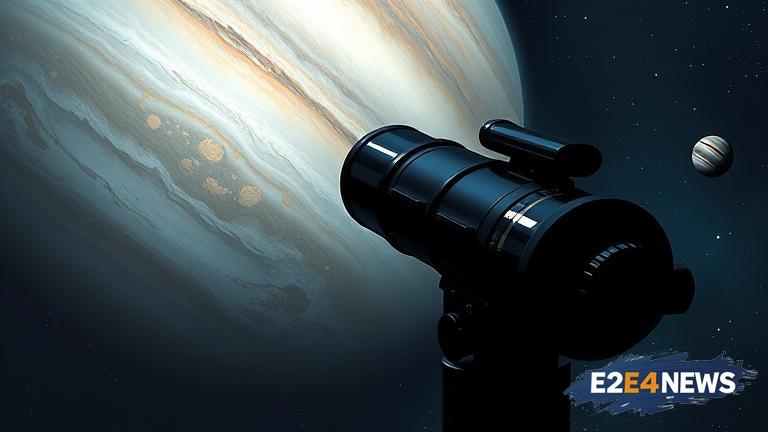The experience of observing Jupiter through a telescope is a truly breathtaking one, offering a glimpse into the vastness and complexity of our solar system. As one gazes upon the planet, they are met with a stunning display of celestial beauty, with vibrant cloud bands and a massive stormy eye that has been raging for centuries. The sheer scale of Jupiter is awe-inspiring, with a diameter of over 89,000 miles, making it the largest planet in our solar system. Through a telescope, one can witness the planet’s rapid rotation, which causes its distinctive banded appearance, with zones of high and low pressure creating vibrant stripes of color. The Great Red Spot, a persistent anticyclonic storm, is a prominent feature of Jupiter’s atmosphere, with winds reaching speeds of up to 400 miles per hour. As astronomers continue to study Jupiter, they are gaining a deeper understanding of the planet’s composition, atmosphere, and magnetic field, which is powered by its incredibly rapid rotation. The planet’s moons, including Io, Europa, Ganymede, and Callisto, offer a fascinating area of study, with each moon possessing its own unique characteristics and features. Io, for example, is the most volcanically active body in the solar system, with over 400 active volcanoes, while Europa’s subsurface ocean is believed to harbor conditions suitable for life. The study of Jupiter and its moons has far-reaching implications for our understanding of the formation and evolution of our solar system, as well as the potential for life beyond Earth. By examining the planet’s atmosphere and magnetic field, scientists can gain insights into the early days of our solar system and the processes that shaped the planets. Furthermore, the exploration of Jupiter’s moons has sparked interest in the possibility of life existing elsewhere in our solar system, with future missions aiming to explore these moons in greater detail. The next generation of telescopes and spacecraft will play a crucial role in advancing our knowledge of Jupiter and its moons, with missions such as the Europa Clipper and the Jupiter Icy Moons Explorer set to launch in the coming years. As we continue to explore and study Jupiter, we are reminded of the vast mysteries that remain to be uncovered in our solar system, and the importance of ongoing scientific research and discovery. The observation of Jupiter through a telescope serves as a powerful reminder of the beauty and complexity of the universe, inspiring future generations of scientists and astronomers to continue exploring and understanding the cosmos. In conclusion, the study of Jupiter is an exciting and dynamic field, with new discoveries and advancements being made regularly, and its exploration will undoubtedly remain a major area of focus for astronomers and scientists in the years to come. The wonders of Jupiter are a testament to the awe-inspiring beauty of the universe, and the importance of continued exploration and discovery. By pushing the boundaries of our knowledge and understanding, we can gain a deeper appreciation for the complexity and majesty of the cosmos, and the many secrets that remain to be uncovered.
